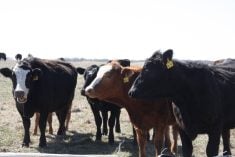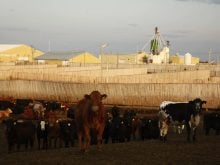This cattle market information is selected from the weekly report from Canfax, a division of the Canadian Cattlemen’s Association. More market information, analysis and statistics are available by becoming a Canfax subscriber by calling 403-275-5110 or at www.canfax.ca.
Fed prices ease lower
Alberta direct cattle sale volumes were moderate last week, and average prices eased modestly lower. Fed steer prices were down 57 cents per hundredweight to average $148.10, and fed heifers dropped $2.05 per cwt. to average $146.48.
Read Also

VIDEO: Ag in Motion documentary launches second season
The second season of the the Western Producer’s documentary series about Ag in Motion launched Oct. 8.
Repeatable live trade was reported at $147 per cwt., steady with last week, and rail sales were steady to $5 per cwt. lower from $245-$250 per cwt. delivered.
Cattle that traded last week were being scheduled for three to five week delivery.
U.S. buying interest was lacklustre, and last week’s cash market again lacked competition. Some of last week’s show list will be carried over into this week. Western Canadian fed slaughter for the week ending Feb. 16 was 10 percent larger than the previous week at 36,765 head and was 25 percent larger than the historic five-year average. Year to date western fed slaughter was reported 12 percent larger at 229,790 head. Year to date Canadian fed cattle-slaughter cow exports to the United States for the week ending Feb. 9 was 34 percent larger than a year ago, totalling 48,842 head.
Canadian steer carcass weights for the week ending Feb. 16 slid 12 pounds lower than the previous week to 918 lb. but were 11 lb. heavier than the same week last year. It should be noted that western Canadian steer carcass weights were 15 lb. lighter than the previous week, averaging 895 lb.
In the outlook, both Canadian and western Canadian weekly fed slaughter volumes have increased over the past three weeks and most recently were the largest seen this year. Packers appear to have ample inventory out front, but the fed harvest is trending significantly larger than last year and the five-year average.
Interest in the cash market is expected to improve, and the extremely weak fed basis could still flush out American buying activity. Feedlot managers are indicating that long fed cattle supplies are dwindling, and softer cattle that have been more susceptible to cold weather are coming in behind. Carcass weights are also expected to tighten.
In the U.S., there was no significant volume trade last week. Feedlot asking prices remained firmly at US$128 per cwt. in the south. Morning bids of $202 per cwt. were passed in the north, and asking prices continued at $207-$207 per cwt. delivered. Average steer carcass weights for the week ending Feb. 2 were three lb. lower than the previous week and last year at 885 lb.
Aggressive cow cull
D2 cow prices have been stuck in a very narrow trading range since the start of the year, averaging from C$82-$84 per cwt. Last week they averaged $83.14 per cwt. They traded $5 per cwt. lower than last year, while Ontario prices are $10.25 per cwt. lower. Slaughter bulls averaged $95.50 per cwt., down $1.05 per cwt. from the previous week.
Based on the Canfax break-even model for cow-calf producers, on a dollars per head basis cow-calf margins were lower in 2018 than 2017. Despite tighter margins, cow-calf producers were still profitable.
However, culling has been aggressive. Western Canadian cow slaughter volumes have been above year ago levels in 25 out of the past 32 weeks. Canadian 85 percent trim prices are trading below last year but are holding up well considering year to date 2019 non-fed beef production is 12 percent larger than last year. Trim prices historically strengthen into the spring, which should support non-fed prices.
Heavy feeders at low point
Trading $1-$4 per cwt. lower last week, feeders weighing more than 800 lb. were at the lowest point since the end of June and beginning of July. Calf and lightweight stocker prices fared better than the heavier weight counterparts as prices traded very close to annual highs.
For many backgrounding operations that bought calves in the fall, feeding margins are not looking great. From a break-even perspective, a lot of calves that were purchased in the fall had break-evens on either side of $190 per cwt. based at 850 lb., targeting the late winter-early spring market. Losses are now projected to be slightly more than $100 per head.
Given there was little if any opportunity to forward contract feeders for spring delivery at a positive margin, one could assume there are a lot of open or unpriced feeder cattle to hit the cash market. Backgrounders could be slow to market their feeders and might look at adding additional weight to their cattle or possibly taking them to finish if the feeder market does not improve.
Year to date Canadian feeder exports to the U.S. are 14 percent larger than last year but 44 percent lower than the five-year average.
A lot of heavyweight feeders being bought now have break-evens on either side of $150 per cwt. as a finished animal heading into the summer. There are significantly more cattle on feed compared to last year, which poses additional price-basis risk for the fed cattle market.
Cut-out price firms
In beef trade, U.S. cut-out values firmed modestly higher last week as buyer interest improved for spring rib and loins. Choice ended last week US$2 per cwt. stronger, at $218.07, while Select firmed $1 per cwt. higher to $211.41.
AAA and AA Canadian cut-out values for the week ending Feb. 8 eased C$2.46 per cwt. and $1.35 per cwt. lower, respectively. All Canadian fresh trim was reported fully steady with the previous week.
















